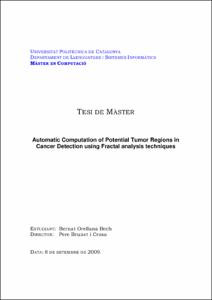Exploració per tema "Tumors"
Ara es mostren els items 1-8 de 8
-
A MAP approach for convex non-negative matrix factorization in the diagnosis of brain tumors

(2014)
(2014)
Text en actes de congrés
Accés restringit per política de l'editorialConvex non-negative matrix factorization is a blind signal separation technique that has previously demonstrated to be well-suited for the task of human brain tumor diagnosis from magnetic resonance spectroscopy data. This ... -
Automatic Computation of Potential Tumor Regions in Cancer Detection using Fractal analysis techniques

(Universitat Politècnica de Catalunya, 2009-09-08)
(Universitat Politècnica de Catalunya, 2009-09-08)
Projecte Final de Màster Oficial
Accés obertRadiology is one of the most active and technologically advanced fields in medicine. It was born from the most advanced physics concepts, and it became a reality thanks to the state-of-the art of electronics and computer ... -
BioFVM-X: an MPI+OpenMP 3-D simulator for biological systems

(Springer, 2021)
(Springer, 2021)
Text en actes de congrés
Accés obertMulti-scale simulations require parallelization to address large-scale problems, such as real-sized tumor simulations. BioFVM is a software package that solves diffusive transport Partial Differential Equations for 3-D ... -
Fabrication and characterization of hydrogels mimicking the tumor environment

(Universitat Politècnica de Catalunya, 2020-11-24)
(Universitat Politècnica de Catalunya, 2020-11-24)
Treball Final de Grau
Accés restringit per acord de confidencialitat -
Feature selection in proton magnetic resonance spectroscopy for brain tumor classification

(2008)
(2008)
Text en actes de congrés
Accés obertH-MRS is a technique that uses response of protons under certain magnetic conditions to reveal the biochemical structure of human tissue. An important application is found in brain tumor diagnosis, due to the known ... -
Modelling the tumour microenvironment in long-term microencapsulated 3D co-cultures recapitulates phenotypic features of disease progression

(2016-02)
(2016-02)
Article
Accés obert3D cell tumour models are generated mainly in non-scalable culture systems, using bioactive scaffolds. Many of these models fail to reflect the complex tumour microenvironment and do not allow long-term monitoring of ... -
Parallel model exploration for tumor treatment simulations

(Parallel model exploration for tumor treatment simulations, 2022-03)
(Parallel model exploration for tumor treatment simulations, 2022-03)
Article
Accés obertAbstract Computational systems and methods are often being used in biological research, including the understanding of cancer and the development of treatments. Simulations of tumor growth and its response to different ... -
Self-assembling as regular nanoparticles dramatically minimizes photobleaching of tumour-targeted GFP

(Elsevier, 2020-02-03)
(Elsevier, 2020-02-03)
Article
Accés obertFluorescent proteins are useful imaging and theranostic agents, but their potential superiority over alternative dyes is weakened by substantial photobleaching under irradiation. Enhancing protein photostability has been ...







